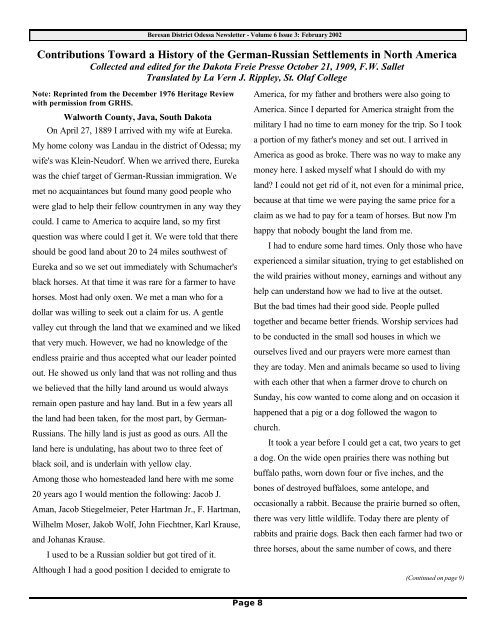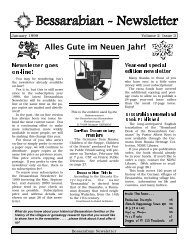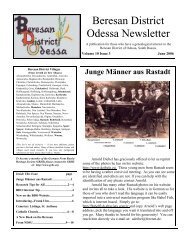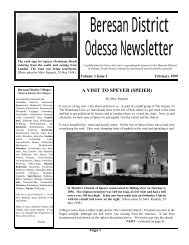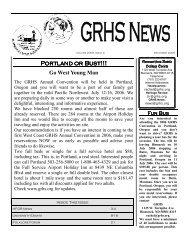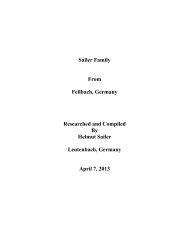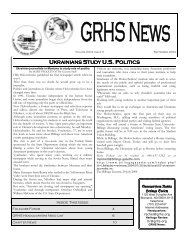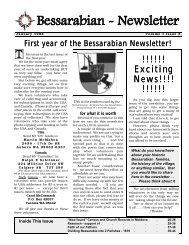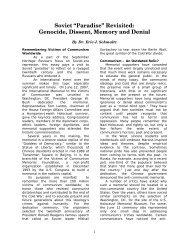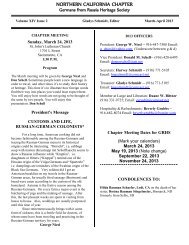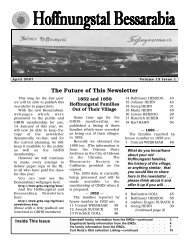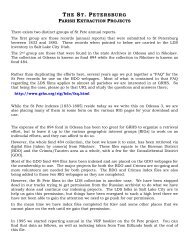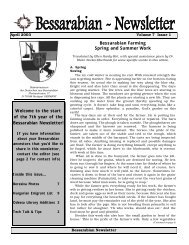You also want an ePaper? Increase the reach of your titles
YUMPU automatically turns print PDFs into web optimized ePapers that Google loves.
Note: Reprinted from the December 1976 Heritage Review<br />
with permission from <strong>GRHS</strong>.<br />
Walworth County, Java, South Dakota<br />
On April 27, 1889 I arrived with my wife at Eureka.<br />
My home colony was Landau in the district of Odessa; my<br />
wife's was Klein-Neudorf. When we arrived there, Eureka<br />
was the chief target of German-Russian immigration. We<br />
met no acquaintances but found many good people who<br />
were glad to help their fellow countrymen in any way they<br />
could. I came to America to acquire land, so my first<br />
question was where could I get it. We were told that there<br />
should be good land about 20 to 24 miles southwest of<br />
Eureka and so we set out immediately with Schumacher's<br />
black horses. At that time it was rare for a farmer to have<br />
horses. Most had only oxen. We met a man who for a<br />
dollar was willing to seek out a claim for us. A gentle<br />
valley cut through the land that we examined and we liked<br />
that very much. However, we had no knowledge of the<br />
endless prairie and thus accepted what our leader pointed<br />
out. He showed us only land that was not rolling and thus<br />
we believed that the hilly land around us would always<br />
remain open pasture and hay land. But in a few years all<br />
the land had been taken, for the most part, by German-<br />
Russians. The hilly land is just as good as ours. All the<br />
land here is undulating, has about two to three feet of<br />
black soil, and is underlain with yellow clay.<br />
Among those who homesteaded land here with me some<br />
20 years ago I would mention the following: Jacob J.<br />
Aman, Jacob Stiegelmeier, Peter Hartman Jr., F. Hartman,<br />
Wilhelm Moser, Jakob Wolf, John Fiechtner, Karl Krause,<br />
and Johanas Krause.<br />
I used to be a Russian soldier but got tired of it.<br />
Although I had a good position I decided to emigrate to<br />
Beresan District Odessa Newsletter - <strong>Vol</strong>ume 6 <strong>Issue</strong> 3: February 2002<br />
Contributions Toward a History of the German-Russian Settlements in North America<br />
Collected and edited for the Dakota Freie Presse October 21, 1909, F.W. Sallet<br />
Translated by La Vern J. Rippley, St. Olaf College<br />
<strong>Page</strong> 8<br />
America, for my father and brothers were also going to<br />
America. Since I departed for America straight from the<br />
military I had no time to earn money for the trip. So I took<br />
a portion of my father's money and set out. I arrived in<br />
America as good as broke. There was no way to make any<br />
money here. I asked myself what I should do with my<br />
land? I could not get rid of it, not even for a minimal price,<br />
because at that time we were paying the same price for a<br />
claim as we had to pay for a team of horses. But now I'm<br />
happy that nobody bought the land from me.<br />
I had to endure some hard times. Only those who have<br />
experienced a similar situation, trying to get established on<br />
the wild prairies without money, earnings and without any<br />
help can understand how we had to live at the outset.<br />
But the bad times had their good side. People pulled<br />
together and became better friends. Worship services had<br />
to be conducted in the small sod houses in which we<br />
ourselves lived and our prayers were more earnest than<br />
they are today. Men and animals became so used to living<br />
with each other that when a farmer drove to church on<br />
Sunday, his cow wanted to come along and on occasion it<br />
happened that a pig or a dog followed the wagon to<br />
church.<br />
It took a year before I could get a cat, two years to get<br />
a dog. On the wide open prairies there was nothing but<br />
buffalo paths, worn down four or five inches, and the<br />
bones of destroyed buffaloes, some antelope, and<br />
occasionally a rabbit. Because the prairie burned so often,<br />
there was very little wildlife. Today there are plenty of<br />
rabbits and prairie dogs. Back then each farmer had two or<br />
three horses, about the same number of cows, and there<br />
(Continued on page 9)


